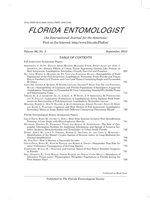This is the first report of Palmistichus elaeisis (Delvare & LaSalle) (Hymenoptera: Eulophidae), a generalist pupal parasitoid of Lepidoptera and Coleoptera, parasitizing pupae of Hypsipyla grandella (Zeller) (Lepidoptera: Pyralidae), a major forest pest in Latin America and the Caribbean. This finding offers new perspectives for the use of parasitoids in biological control programs against pests of mahogany and cedar species in Latin America and the Caribbean.
Hypsipyla grandella (Zeller) (Lepidoptera: Pyralidae) is distributed throughout Central and South America (except Chile), and inhabits many Caribbean Islands and the southern tip of Florida (Schabel et al. 1999). Only 1 caterpillar per tree causes severe damage; and it is the main pest to meliaceous trees. Larvae attack shoots, leaves, stems, fruits and even the trunk of trees of many species of subfamily Swietenoideae, including several mahogany and cedar species (Hilje & Cornelius 2001). Boring in terminal shoots of young big leaf mahogany, Swietenia macrophylla King breaks apical dominance, causing forking of the stems and excessive production of lateral branches (Howard & Giblin-Davis 1997; Schabel et al. 1999). The use of systemic insecticides injected into the trunk has shown effective control of H. grandella, but chemical control in forest plantations is unfeasible due to potentially adverse environmental effects and high costs (Zanuncio et al. 1994). Thus, biological control through the introduction or augmentation of predators, parasitoids and/or pathogens, could be an important tool (Silva 2000). Taveras et al. (2004) reported 4 parasitoid species in Costa Rica, but their effect on H. grandella abundance was negligible.
Palmistichus elaeisis (Delvare & LaSalle 1993) (Hymenoptera: Eulophidae) (Fig. 1) is a generalist and gregarious endoparasitoid of lepidopteran and coleopteran pupae (Menezes et al. 2012). This parasitoid parasitizes pests in eucalyptus plantations such as Eupseudosoma involuta (Lepidoptera: Arctiidae), Euselasia eucerus (Lepidoptera: Riodinidae), Sabulodes sp. (Lepidoptera: Geometridae), Thyrinteina arnobia, Thyrinteina leucoceraea (Lepidoptera: Geometridae), Hylesia sp. (Lepidoptera: Saturniidae), and Sarsina uiolascens (Lepidoptera: Lymantriidae) (Delvare & LaSalle 1993; Bittencourt & Berti Filho 1999; Pereira et al. 2008; Zanuncio et al. 2008; Soares et al. 2009; Zaché et al. 2012).
Fig. 1.
Palmistichus elaeisis female parasitizing a Hypsipyla grandella pupa (a); parasitoid emergence hole (b).

The objective of this study was to evaluate the parasitism of P. elaeisis on H. grandella pupae. The experiment was conducted in laboratory conditions.
Parasitoids were originally collected from pupae of E. eucerus from eucalyptus plantations at Lençois Paulista, São Paulo State, Brazil, in 2011. Thereafter, a laboratory colony was maintained using Spodoptera frugiperda (J. E. Smith) (Lepidoptera: Noctuidae) as the host. Hypsipyla grandella was reared under controlled conditions on S. macrophylla plants until the pupal stage in a room mantained at 26 ± 2 °C, 60 ± 10% RH and 12:12 h L:D. Pupae were individually placed in glass tubes (14 cm L × 2 cm diam, covered with “voile” fabric) containing 20 mated P. elaeisis females fed on pure honey that were placed inside the tubes 24 h before. Pupae were exposed to parasitoids for 72 h and then placed in plastic trays in a climatized room at 25 ± 2 °C, 70% RH and 12:12 h L:D until adult emergence. Twenty H. grandella pupae were exposed to P. elaeisis. Parasitoids emerged 24 days later. Parasitism reached 80%, with an emergence rate of 70%; 79.1 ± 1.3 (SE) adult parasitoids emerged per parasitized pupa. The generalist behavior and mass production capabilities characterize P. elaeisis as a promising agent for use in control of lepidopteran pests. Research is underway to design mass rearing and release techniques for field evaluations and potential use of P. elaeisis in mahogany shoot borer control.





